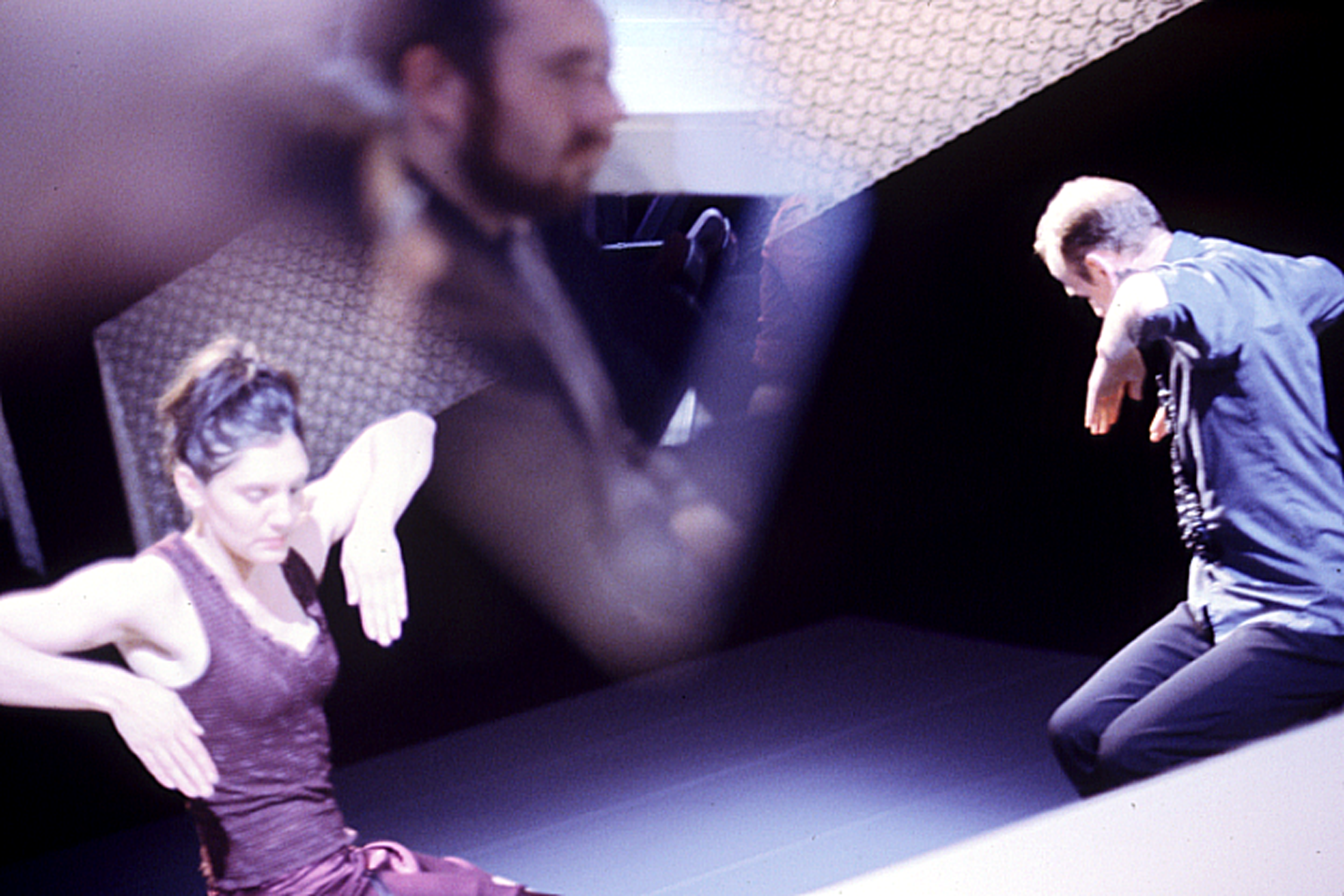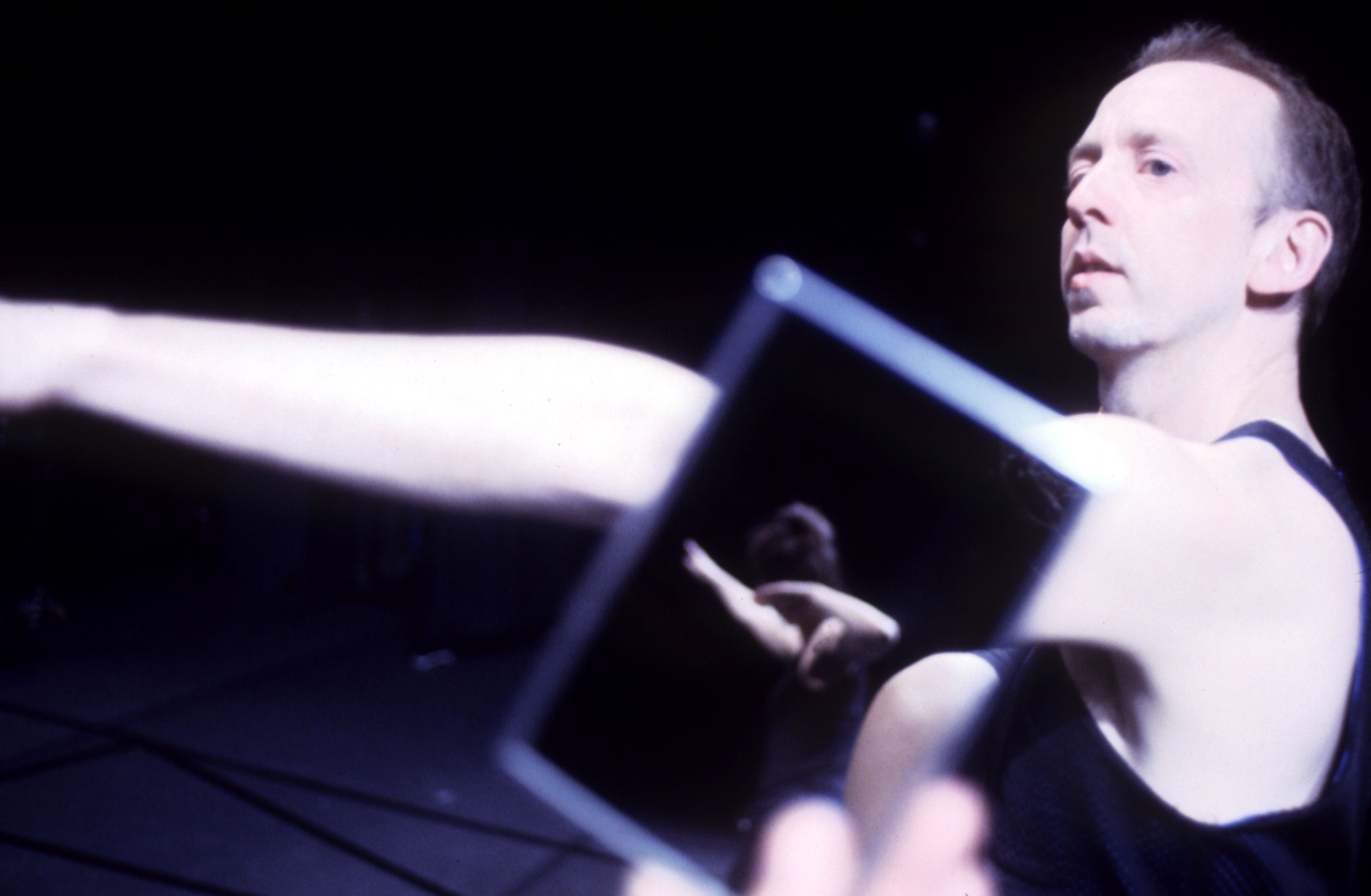just two dancers (2003)
CONCEPT, DIRECTION & VISUAL DESIGN: John Jasperse
CREATED & PERFORMED BY: John Jasperse and Juliette Mapp
ORIGINAL MUSIC: Chris Peck
LIGHTING DESIGN: John Jasperse and Joe Levasseur
JULIETTE MAPP’S COSTUME DESIGN: Kathy Kemp/ Anna
Description:
just two dancers is a duet work centered on perception. In contemporary culture, great value is placed on being forward thinking, on planning ahead. The notion that one should be goal oriented is assumed. Perception is thus thought to be ideally focused primarily if not solely in one direction – ahead.
The fact that our eyes see in one direction (ahead and not behind) has greatly informed this unidirectional cultural focus. Over 70% of our experience is defined through the sense of vision. What is behind becomes less important by sheer virtue of the fact that we cannot see it unless we turn, which thereby merely shifts our sense of what is “front.” The traditional architecture of a theater has embedded in its design a reinforcement of this spatial hierarchy. By placing seats oriented in the same direction, the audience’s focus is projected forward into the performing area.
just two dancers examines a more dynamic and multi-directional sense of perception. While the seats of the theater face in one direction, the unidirectional focus is subverted by constructing small platforms within the audience space that will act as auxiliary stages. In the work the two dancers in the duet at times perform in separate areas of the space, sometimes with one dancer behind a majority of the audience. By creating a unified three-dimensional performance experience that surrounds the viewer, the spectator would normally be forced to choose one or the other performer to watch. Each audience member will be given a hand mirror to reflect all or parts of one dancer into their field of vision while watching the second dancer. Through the simple device of the mirror the singular direction of the audience’s vision is overturned as the audience begins to receive visual information from two directions simultaneously in the space. By giving each audience member the power to manipulate his/her own mirror, the spectator is in essence empowered to define the spatial design of his/her experience. At the same time, each spectator is confronted with a reflection not only of the otherwise unseen dancer but of themselves, hence they are forced to watch both the dance and themselves watching the dance.
Thus, the mirror becomes both a means to see the entire performance and a vehicle to heighten the audience’s awareness of the mechanics of their own perception. By placing stages within the audience space, each audience member will be privy to intensely intimate spatial relationships to the performers. Perspectives will shift as the dance passes in front of, above, behind and beside the audience, moving from extreme distance to direct physical contact through touch with an audience member. Through this, relations may unfold between what is seen, what is heard, what is felt and even at times, what is smelled.
Performances:
WORLD PREMIERE: Dance Theater Workshop (NYC), May 22 – June 8, 2003
Kanuti Gildi Saal (Talliin, Estonia), August 30, 2003
BucharEst.West Festival, Bulandra Theater (Bucharest, Romania), October 5, 2003
The Red House (Sofia, Bulgaria), October 11, 2003
Confrontations Festival (Prague, Czech Republic), October 16, 2003
Moderna Dansteatern (Stockholm, Sweden) October 25-26, 2003
Florida Dance Association, Byron Carlyle Theater (Miami, FL), June 25-26, 2004
La Biennale di Venezia, Teatro Alle Tese (Venice, Italy), July 22-23, 2004
Tanzquartier Wien (Vienna, Austria), October 14-16, 2004
The Flynn Center for the Arts (Burlington, VT), November 10-12, 2004
Festival Internacional Teatro a Mil, Teatro Universidad Católica (Santiago, Chile), January 12-16, 2005
Gestión Urbana, Sala Calaucán (Concepcion, Chile), January 19, 2005
Producción Cultural, Teatro Mauri (Valparaiso, Chili), January 21, 2005
On the Boards, Behnke Center for Contemporary Performance (Seattle, WA), February 3-6, 2005
V.E.O. Festival (Valencia, Spain), February 26-27, 2005
Press:
Points of View – Deborah Jowitt, The Village Voice 6/10/03
Two Dancers, 15 Platforms, Many Mirrors – Robert Greskovic, The Wall Street Journal 5/29/03
THE LISTINGS | DEC. 2–DEC. 8; JOHN JASPERSE – Claudia La Rocco, NYTimes 12/2/05
Performance blurs lines between dancers, audience – Brangien Davis, The Seattle Times 1/28/05
La aclamada pieza “Just two dancers” se presenta este sábado en el Teatro Mauri – El Mercurío De Valparaiso 1/19/05
Cosmopolitan colophon – Roger Rooms, El País 7/25/04
August kahe tule vahel – Postimees 9/5/03
Video:
Project Funders:
The presentation of just two dancers at Dance Theater Workshop was made possible by Michael and Tina Connelly of the David R. White Producers Circle. just two dancers was commissioned by DTW’s Bessie Schönberg/First Light Commissioning Program with funds provided by The Mertz Gilmore Foundation. just two dancers was a co-commissioning project by The Florida Dance Association in partnership with Dance Theater Workshop, The Flynn Center for the Performing Arts and the National Performance Network Creation Fund. The Creation Fund is sponsored by The Doris Duke Charitable Foundation and Altria Group, Inc. John Jasperse Company has received funds from the Lila Acheson Wallace Theater Fund, established in The New York Community Trust by the founders of The Reader’s Digest Association and Altria Group, Inc. Performances at DTW were made possible with public funds from the New York State Council on the Arts, a state agency. Funds for just two dancers have been provided in part by the Greenwall Foundation, the Harkness Foundation for Dance, the Jerome Foundation of St. Paul, MN, the James E. Robison Foundation, the National Endowment for the Arts and through a developmental residency at Hollins University. Commission and live performance of the score was made possible by the Live Music for Dance Program of the Mary Flagler Cary Charitable Trust, administered by the American Music Centers.


